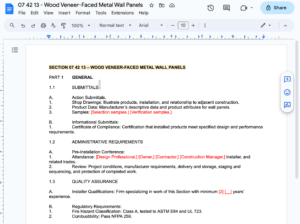Construction specifications, often referred to as “construction specs,” are detailed documents outlining the types of materials and workmanship required for a construction project. Here are seven facts about them:
- Integral Part of Construction Documents: Construction specs accompany blueprints and drawings, providing a comprehensive description that outlines the standards, materials, and workmanship for the project.
- Three Main Types: There are generally three types of construction specs: prescriptive (detailing the materials and work methods to be used), performance (stating the outcomes that the final construction must achieve), and proprietary (specifying products from specific manufacturers).
- Detailed vs. General: Construction specs can be long-form, which are very detailed and often customized for a specific project, or short-form, which are more general, using standardized language to cover common elements of construction.
- Legally Binding: Specs are part of the legal documents in contract bidding and thus become legally binding once a contract is signed, detailing what is expected of the contractor and subcontractors.
- Guidance for Bidding: They are used during the bidding process to provide contractors with the information needed to propose a bid that is as accurate as possible regarding cost and materials.
- Quality Control: Specs serve as a reference point for quality control during and after the construction process, helping ensure the project is built to the required standards and can pass inspections.
Understanding construction specifications is crucial for anyone involved in building and design, as they ensure that all parties have a clear and common understanding of the project’s requirements.



